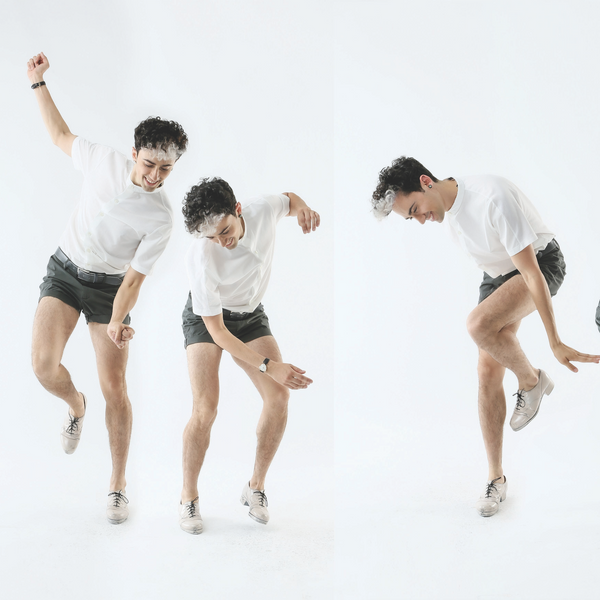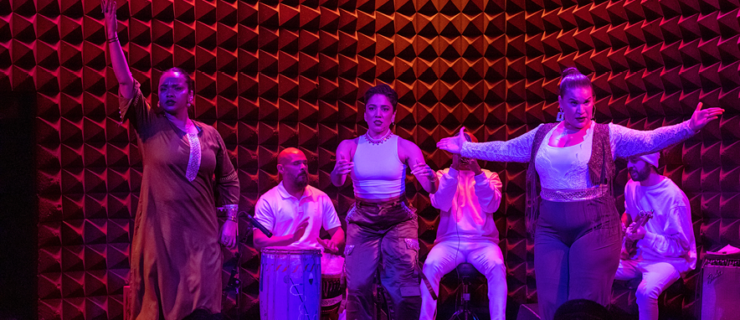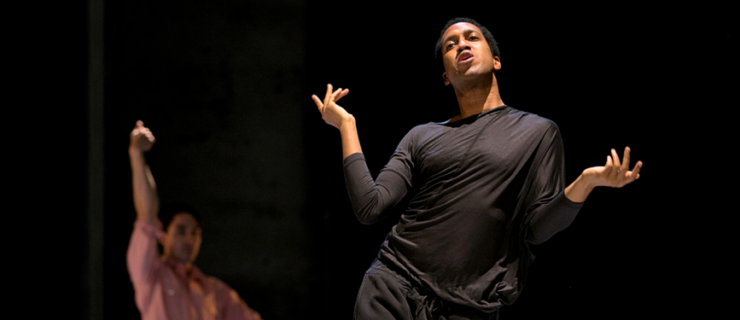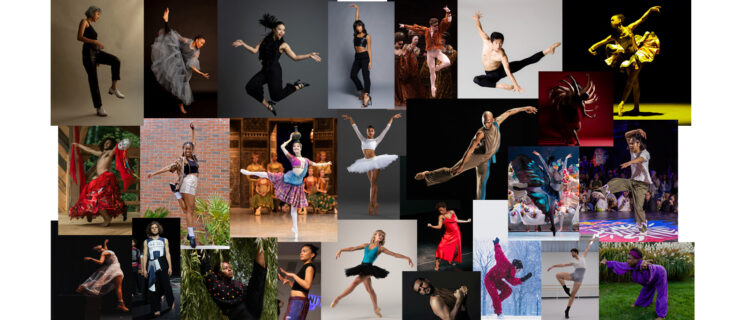How Caleb Teicher Became King of Old-School Cool
When Michelle Dorrance put on her first show as Dorrance Dance in 2011, in a shared evening with Dormeshia Sumbry-Edwards, a charismatic teenager was featured in both choreographers’ works. Critic Gia Kourlas described Caleb Teicher in The New York Times as “a sleek dancer who possesses a beguiling combination of a relaxed upper body with switchblade feet.” His appearance won him a Bessie for Outstanding Individual Performance.
The day after the award ceremony, he was back in class—ballet class. His growing reputation as a hot young tap dancer was making Teicher nervous that he would find himself pigeonholed before he had time to explore other options. So, he aggressively pursued anything that would let him be “not a tap dancer.”
He packed the next five years with experience across the board: a six-month apprenticeship with Camille A. Brown & Dancers; a yearlong contract touring Europe with West Side Story; a stint as associate choreographer to Chase Brock. He also discovered Lindy hop, and got hooked on the scene’s focus on dancing for the joy of it, like musicians jamming. All the while he continued to dance regularly with Dorrance. And he delved into his most persistent passion: choreography.
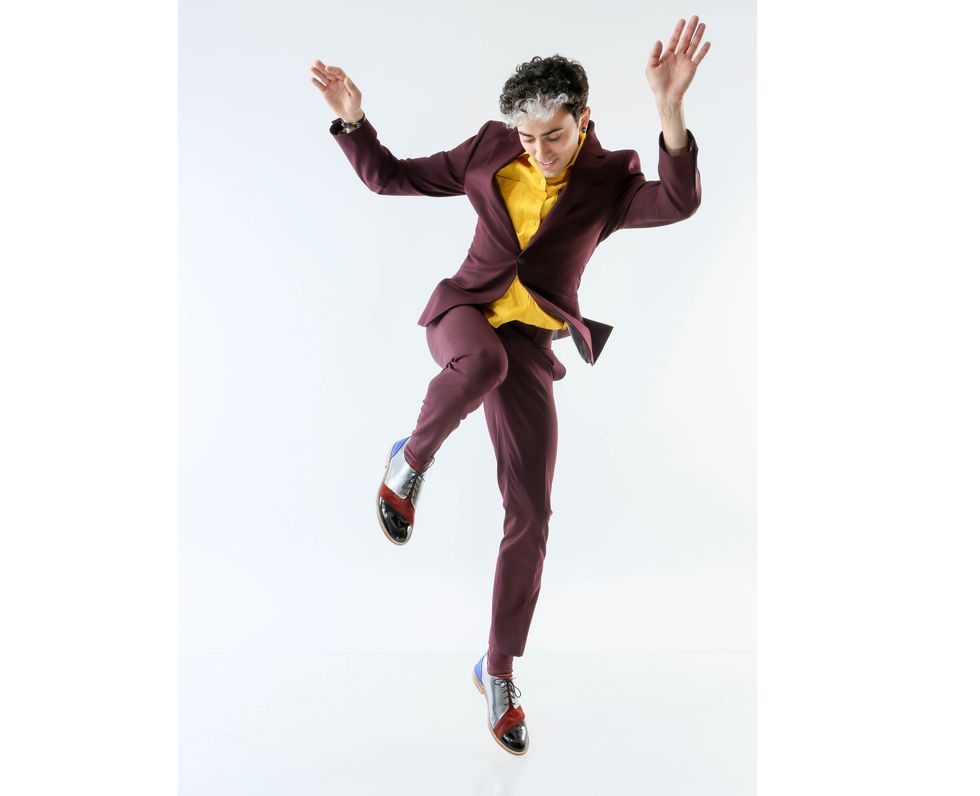 Jayme Thornton
Jayme Thornton
Today, Teicher may only be 26, but New York City Center, La MaMa, The Yard, CUNY Dance Initiative, Jacob’s Pillow and Works & Process at the Guggenheim have all commissioned and presented his work. Last year, musician Ben Folds invited Teicher to the Kennedy Center for the Ben Folds Presents Declassified series with the National Symphony Orchestra, where he shared the stage with Regina Spektor and Jon Batiste.
Spektor loved working with him so much she invited him to be part of her own show on Broadway this summer; he danced to four of her songs, including one in which just the two of them performed together on the dance floor. During the run, he found out he’d been nominated for three more Bessies.
Yet despite such early successes, Teicher maintains an unaffected charm. When I caught up with him at New York City Center, where he is currently a choreography fellow, he had a pair of mint green roller skates dangling around his neck—ready for some recreational skating and swing dancing after our interview. With a faint awareness of a master plan, a keen antenna for a fun project and a rare sense of chill in the midst of any work in progress, Teicher has mastered a relaxed balance of journey and destination.
Teicher started tap at age 10. His father, a successful studio singer, was always singing around the house, and his mother, a magazine editor, taught guitar in high school. Teicher started drumming at 8. Then he saw some guys tap dancing on a TV talent show.
“It just made sense,” he says. “I heard it in the way that I heard percussion.”
He joined an all-boys beginner tap class at the Northern Westchester Center for the Arts, about 30 minutes from home in Mahopac, New York. Picking up the material felt immediately familiar to the young drummer: “I wasn’t battling the idea of rhythm,” he says. “It was just about weight changes. And coordinating.”
Teicher made his first solo only six months after starting lessons. “I would reflect on the steps I learned in class by making my own little combos and exercises. My own little ditties.”
At 13, Teicher found David Rider, whom he calls the most remarkable teacher he’s ever met. “He’d say, ‘This is Jimmy Slyde month and we’re going to watch a different Jimmy Slyde clip at the beginning of each lesson,’ ” Teicher recalls.
The way that Rider integrated tap history helped Teicher understand how his dancing fit in the lineage of tap and jazz dance. As a white male, parallels to Gene Kelly and Fred Astaire were encouraged at an early age, but Teicher found more inspiration from legendary dancers, like Slyde and Ann Miller, and modern-day greats Michelle Dorrance, Dormeshia Sumbry-Edwards, Jason Samuels Smith and Ayodele Casel. “And Dianne Walker! Absolutely my favorite tap dancer, still to this day. Her dancing is like a warm hug,” says Teicher.
Both Rider and, later, Dorrance, his director-cum-mentor, reinforced in him that history matters. “The African-American legacy of this dance should be honored, even while pushing boundaries,” he says.
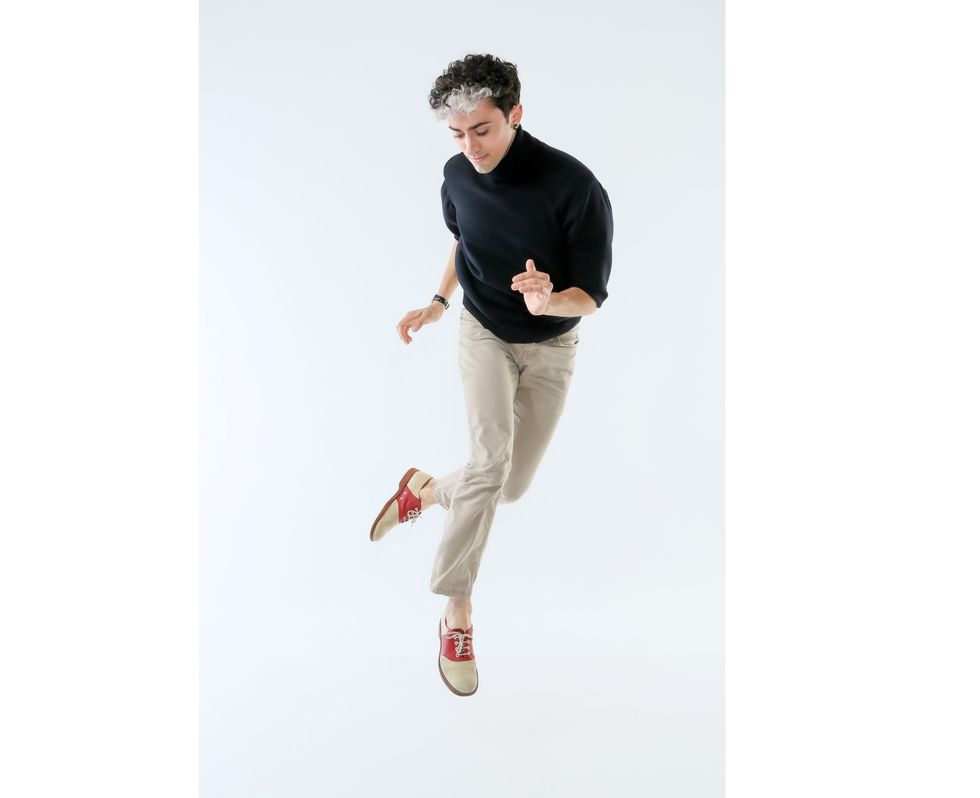 Jayme Thornton
Jayme Thornton
He first met Dorrance during his teenage years in festival performances. At 17, he moved to New York City and started going to her 7:30 pm tap class at Broadway Dance Center. Dorrance told him, “I’m going to put you in everything!” And she did.
After five years of dancing with Dorrance and gaining as many experiences outside of tap as he could, Teicher launched his own troupe, Caleb Teicher & Company, when he was only 22. “I love sharing what I do with people—the making of it, the performing of it, the experience of it,” he says. “It is my small way of trying to make the world I want to live in.”
His company performs tap, vernacular jazz, Lindy hop and a mix of other dance styles, taking historically American dance forms in modern-day directions—whether Teicher’s tap dancing in heels or making a 25-minute swing dance duet with his friend Nathan Bugh to Ella Fitzgerald love songs.
Gender is undeniably in focus. However, it is broached through the lens of an artist who is less concerned with pushing society’s boundaries and more with broadening his own.
“I try not to make decisions simply because they will be subversive, because they won’t be subversive very long,” he says. “Tap, jazz and swing dance are forms which naturally enforce present-day narratives such as diversity, inclusivity and equality.” He encourages his dancers to be their unique selves so long as they are sonically unified. “It’s more like a jazz band,” he explains.

Teicher rehearsing Swing 2020
Rachel Papo
His open, curious attitude is contagious. “Caleb’s confidence makes him generous and open and adaptable,” says Conrad Tao, the composer/pianist who collaborated with Teicher on last season’s More Forever. “That’s why people want to work with him. He gives people a sense that he can pull it off.”
Yet despite early success, he’s always up for trying something new. “Caleb is freakishly free of hang-ups and judgment,” says Ben Folds. “That’s rare. He’s not overly precious, yet he gravitates towards something unique every step of the way.”
Teicher carefully measures risks—pushing himself to do new things within certain known, safe parameters. He might be dancing on just a sliver of stage in front of a full orchestra at the Kennedy Center, performing an hour-long improvised duet with percussive dancer Nic Gareiss or setting his company’s Fall for Dance commission to the accompaniment of beatboxer Chris Celiz. Part of his safety zone is working with musicians because they speak the same language: music.
As his company gets more commissions, Teicher now finds himself running a small business. “Dancing in my work and doing it at a particular level is one challenge,” he says. “Making the work, and keeping the work at that level is another. And then there’s putting together paperwork, schedules, and all the money, time and energy of organizing a full year of performances—it’s a very different thing.”
This season, he will embark on his biggest project yet: Swing 2020, two weeks of performances at The Joyce Theater with 12 dancers and a 10-piece big band. He is excited to collaborate with a brain trust of swing dancers on the project: Nathan Bugh, Evita Arce, LaTasha Barnes.
The team wants to show what swing dance is today: respectful of the past, hopeful for the present and demanding of the future. Not unlike Teicher himself.
